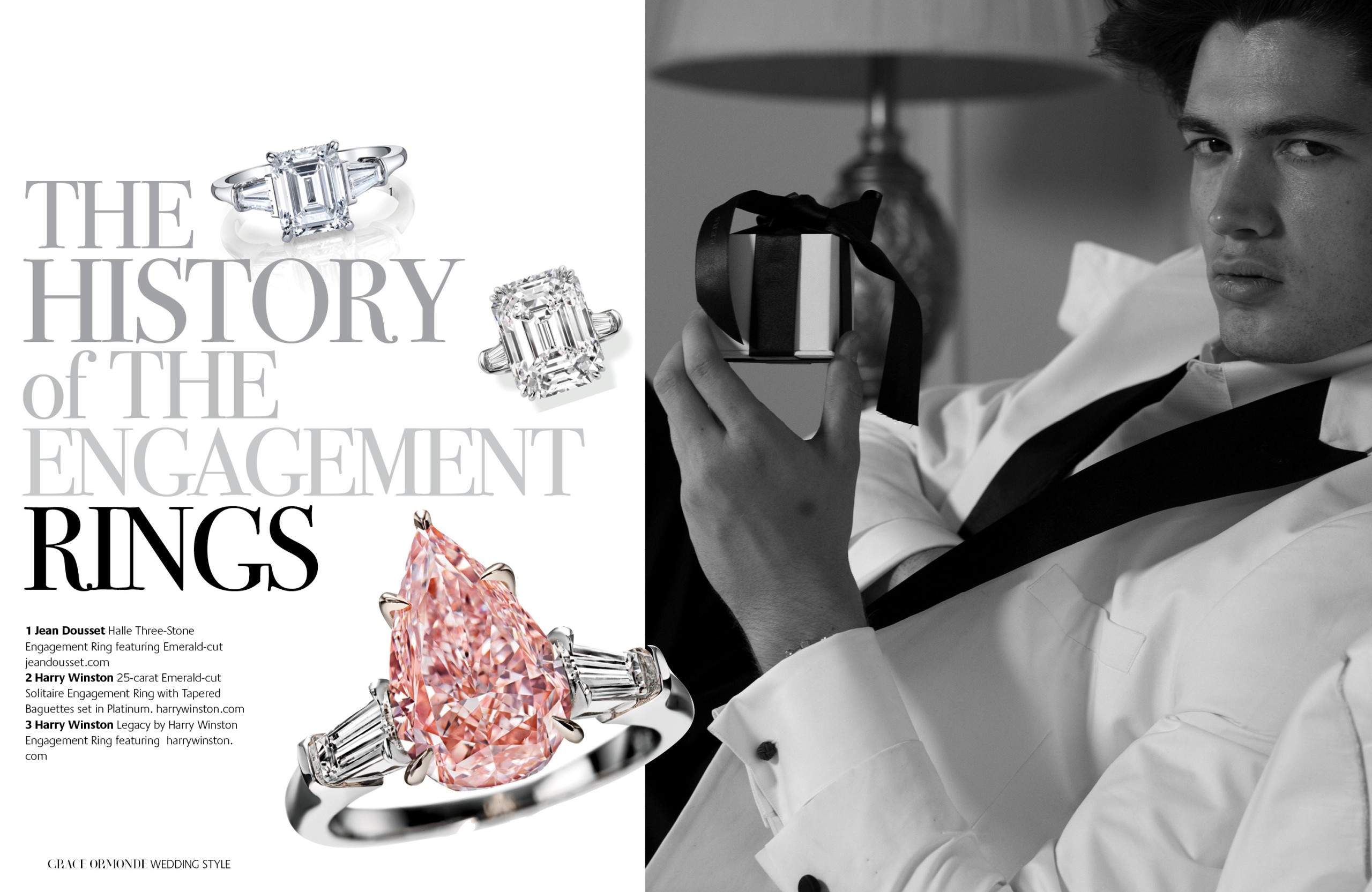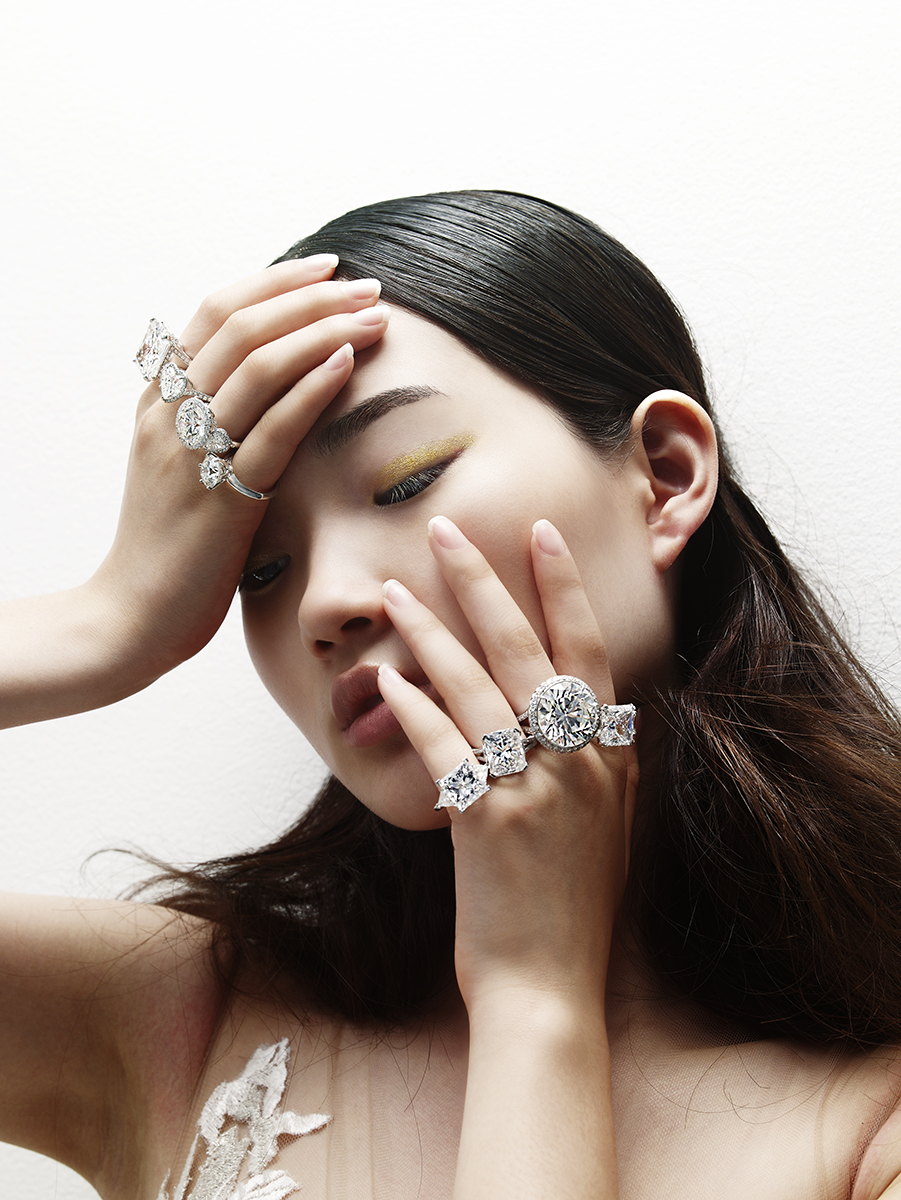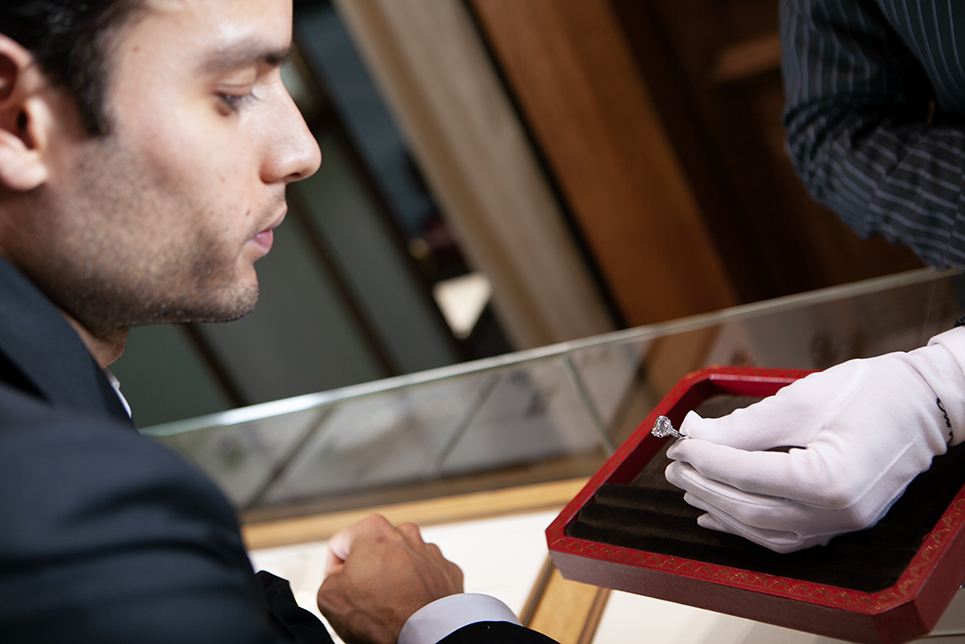
As Seen in Grace Ormonde Wedding Style Photography by: Kellie Walsh, 4 Eyes Photography
1. Jean Dousset Halle Three-Stone Engagement Ring featuring Emerald-cut 2. Harry Winston 25-carat Emerald-cut Solitaire Engagement Ring with Tapered Baguettes set in Platinum 3. Harry Winston Legacy by Harry Winston Engagement Ring featuring
THE HISTORY OF THE ENGAGEMENT RINGS
The history of engagement rings does not begin with a bouquet of romance, but the love between certain famous couples definitely helped shape it.
This long roller coaster of a journey connects culture, religion, legality, economics and fashion to the pledge of commitment and love. You may know a little about the history of engagement rings, but there’s so much to unpack, you’re sure to be surprised!
While the Ancient Egyptians are credited with the first wedding ring (which they constructed from braided reeds or leather), who created the first engagement ring? What was the inspiration for the modern wedding band? When and why did men start wearing wedding rings? The Puritans wore WHAT?!
From iron rings to diamonds to dual-ring ceremonies, engagement rings have had quite the transformation.
Let’s dive into the history of engagement rings and learn more about their fascinating evolution.
EARLY HISTORY: FROM CONTRACTS TO SACRIFICES
While engagement rings signify a bond and promise of eternal love today, back thousands of years ago, they were worn more for contractual purposes. Historians believe that the first engagement rings originated from Ancient Roman around 200 B.C., where they symbolized obedience or a legal contract. Women in Ancient Rome wore engagement rings made of flint, bone, ivory, bronze or iron. No, these humble rings did not sport diamonds, but the rings were worn on what we now call ring fingers. This tradition originated from the Ancient Roman belief that the fourth finger on the left hand had a “vein of love” that attached to the heart.
By the second century A.D., gold rose to the most popular type of engagement ring. However, men would gift their bride-to-be two rings. In contrast to today’s enthusiasm for wearing a fake engagement ring while traveling, women in Ancient Rome would often wear an iron ring while at home, with the iron signifying strength, and then would wear a flashier gold ring when they left the home to represent wealth.
Did you know that a Pope played a significant role in the history of engagement rings? Pope Nicholas I, who was also known as Nicholas the Great, is credited with stating that the engagement ring is a monetary sacrifice that indicates a man’s intention to marry a particular woman. The engagement ring has held its modern meaning since 850 A.D.

As Seen in Grace Ormonde Wedding Style Photography by: Michael David Adams
Mid-History: The Highs and Lows
You may be wondering when diamonds made their introduction in the history of engagement rings. The first record of a diamond engagement ring was in 1477, when Archduke Maximilian of Austria asked Mary of Burgundy to marry him. Although this was the birth of the diamond engagement ring, it would take many more centuries for this trend to catch on and become the norm.
The minimal interest in diamond engagement rings was primarily due to the low supply and high price of diamonds at the time. India used to be the only country that mined and sold diamonds, so diamond rings were a luxury enjoyed by the world’s most wealthy individuals. Once diamonds were discovered in Brazil in the 1700s, prices for these rings began to drop. As time went on, European jewelers started to cut the diamonds and implement other techniques to increase diamond rings’ glamor and lure.
Despite the diamond scarcity, the Renaissance Period begat a more romantic embodiment for engagement rings. In the 16th century, married women would wear gimmel rings, which are rings that consist of two or more bands that ultimately form one ring. During this time, an engaged couple would each wear one band, and then during the betrothal ceremony, all of the bands would be connected for the bride to continue to wear as a married woman.
Posey rings were favored in the 17th century and were the inspiration for today’s wedding bands. If you’ve never heard of posey rings before, they are bands with carved inscriptions. In the 1600s, men often presented their brides-to-be with silver posey rings, containing brief love poems or songs inscribed on the interiors of the rings. Then the brides would receive gold posey rings during their marriage ceremonies.
However, engagement rings weren’t beloved by all. In the mid-17th century, Puritans in England renounced engagement rings, because they believed the rings showcased commitment to the clergy or irreligion. Puritans actually found the wearing of any jewelry as a sin and brought that belief with them when they colonized the U.S. Instead of engagement or wedding rings, the Puritans would use thimbles. The new brides would then cut off the bottom of the thimble and wear that as a wedding band.

As Seen in Grace Ormonde Wedding Style Photography by: Ed Hafizov, Zorz Studios
Modern History: Diamonds May Not Be Forever
Did you know that Queen Victoria of the United Kingdom is credited with the resurgence of the engagement ring? Despite the engagement ring losing popularity in the later half of the millennium, Prince Albert of Saxe-Coburg and Gotha gave Queen Victoria an extraordinarily thoughtful engagement ring he had designed in 1839. Shaped like a serpent, the 18-karat gold ring had rubies as eyes, a large green emerald (her birthstone) in the center and a diamond for its mouth. You could say this snake was quite the charmer and left a lasting impression on the masses, playing a pivotal role in the history of engagement rings.
Diamond engagement rings made their way to the U.S. around 1840, and the detection of diamonds in South Africa in 1867 led to an increased diamond supply for the world to enjoy. In the early 1900s, engagement rings commonly had one large diamond with small, encrusted diamonds on the setting. The most popular diamond cut was a round cut, until the cushion cut and solitaire setting rose to the forefront in the mid-’40s. Platinum was the premier choice for engagement rings until World War II, and then yellow gold took the spotlight.
Financially hard-hitting events such as World War I and The Great Depression greatly reduced Americans’ interest in purchasing diamond engagement rings. Instead, simple bands or rings with less expensive gems were highly favored. After the economy began to bounce back, diamond engagement rings’ popularity soared to new heights.
While dual-ring ceremonies were pioneered by the Greek Orthodox Church in the 14th century, they weren’t frequent in the U.S. until World War II. With so many men heading overseas to war, a lot of couples opted to quickly marry with both partners receiving wedding bands. The men’s bands represented souvenirs of the love they have for their wives, so despite the distance, the soldiers would always be reminded of their wives and families back home. A whopping 85 percent of marriages during the time had dual rings, and the tradition hasn’t left our country since.
De Beers’ infamous “A diamond is forever” marketing campaign launched in 1948, primarily catching the eyes of Hollywood celebrities, who flaunted their diamond engagement rings and boosted the stone’s popularity. But with the compromised economy and increasing preference to be unique, more and more Americans have been choosing colored gemstones with a wide variety of cuts and elaborate settings.
